South Dakota has a diverse bird population with over 400 species identified. Among these are several species of red birds that are found throughout the state’s varied habitats, including grasslands, forests, wetlands, and waterways.
These red birds are notable for their striking plumage and are popular among birdwatchers and nature enthusiasts.
In this article, we’ll explore some of the most common red birds found in South Dakota and learn more about their unique characteristics and behavior.
1. American Robin

The American robin is a migratory bird belonging to the true thrush genus and Turdidae family.
It was named after its European counterpart due to the similar reddish-orange breast they possess; however, they are not closely related.
This species can be seen through most of North America during winter months and in parts of Mexico and Central America, where it also breeds.
They have plump bodies with gray upperparts and white underparts that vary from yellow on their throats down to orange toward their bellies.
Robins feed on fruits such as berries or insects like worms, making them an important part of ecosystems by helping disperse seeds naturally throughout these areas.
Scientific classification:
| Kingdom | Animalia |
| Phylum | Chordata |
| Class | Aves |
| Order | Passeriformes |
| Family | Turdidae |
| Genus | Turdus |
| Species | T. migratorius |
Also Featured In: Most Common United States Birds, Flocks Birds around Us
2. Downy Woodpecker
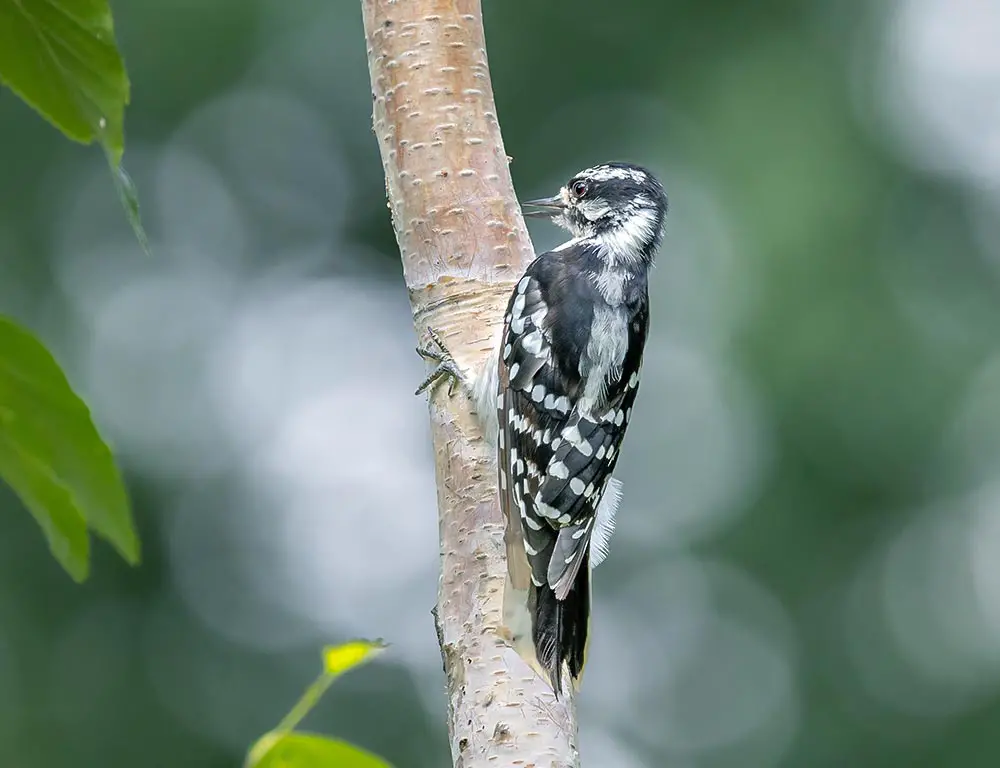
The downy woodpecker is a small species of woodpecker found in North America. Growing up to 7 inches long, it can be identified by its white belly and spotted wings.
It inhabits forests throughout the United States and Canada, with the exception of deserts in the southwest and northern tundra.
This bird nests in tree cavities and feeds mostly on insects but will supplement its diet with fruit or nuts when available.
The Downy Woodpecker has an unmistakable call that sounds like a loud ‘piker,’ similar to other members of its family, such as the Hairy Woodpecker.
Scientific classification:
| Kingdom | Animalia |
| Phylum | Chordata |
| Class | Aves |
| Order | Piciformes |
| Family | Picidae |
| Genus | Dryobates |
| Species | D. pubescens |
Also Featured In: Birds Live in Arkansas, Summer Birds that Live around Us
3. House Finch

The House Finch is a finch species native to western North America and has been introduced in the eastern half of the continent and Hawaii.
It’s an average-sized finch with adults measuring 12.5 – 15 cm (5 – 6 inches) long and with a wingspan between 20 – 25 cm (8 – 10 inches).
The upperparts are brown, while its underparts range from pale grayish white to yellow depending on subspecies.
Its face is streaked or spotted with reddish coloration; males typically have brighter plumage than females due to sexual dimorphism.
They’re mostly found near human habitations such as farms and gardens, where they feed on grains, fruits, insects, etc., making them very popular among birders who want something colorful for their backyard.
Scientific classification:
| Kingdom | Animalia |
| Phylum | Chordata |
| Class | Aves |
| Order | Passeriformes |
| Family | Fringillidae |
| Subfamily | Carduelinae |
| Genus | Haemorhous |
| Species | H. mexicanus |
Also Featured In: Birds Live Near San Diego, Common Birds in the Cities
4. Red-Winged Blackbird

The red-winged blackbird is a beautiful bird found in most of North America and Central America.
Its distinct features include a glossy black body, with white shoulder patches and bright red wing coverts year round.
It prefers wetland habitats such as marshes, ponds, lakeshores, and agricultural fields. During breeding season, they inhabit grassy areas near water, then move south for the winter months.
For food, they mainly eat insects but also consume wild fruit or grains.
They are very social birds, often seen in large flocks during migration times when their unmistakable “conk-la-ree” call can be heard echoing across the sky.
Scientific classification:
| Kingdom | Animalia |
| Phylum | Chordata |
| Class | Aves |
| Order | Passeriformes |
| Family | Icteridae |
| Genus | Agelaius |
| Species | A. phoeniceus |
Also Featured In: Birds Commonly Found in Northern California, Birds that Calls in the Morning
5. Red-Breasted Nuthatch

The Red-breasted Nuthatch is a beautiful and vocal songbird that can be found in coniferous forests across Canada, Alaska, the northeastern United States, and the western US.
This small bird has blue-grey upperparts with cinnamon underparts, a white throat and face with black eye stripe, a straight grey bill, and a black crown.
Its call sounds like a tin trumpet; it’s high-pitched yet nasal.
During mating season, they form monogamous pairs to build their nest near tree trunks or branches at low heights off the ground, where they lay 2 – 8 eggs at once.
They are very active little birds who love clinging to trees while searching for insect larvae or seeds within the bark of trees, which helps control pest populations.
Scientific classification:
| Kingdom | Animalia |
| Phylum | Chordata |
| Class | Aves |
| Order | Passeriformes |
| Family | Sittidae |
| Genus | Sitta |
| Species | S. canadensis |
Also Featured In: Common Birds in Canada, Blue Birds You’ll Found around Us
6. Pine Grosbeak
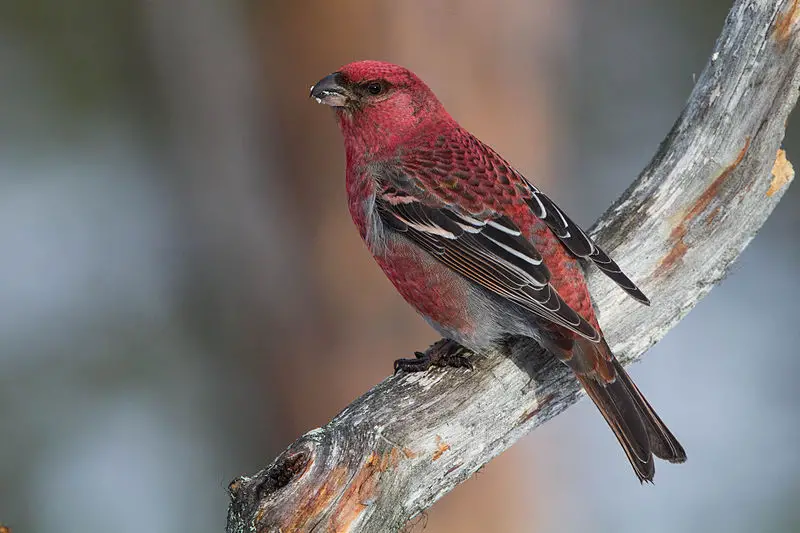
Pine grosbeak is a beautiful bird from Alaska, the western US, Canada, and Fennoscandia to Siberia. It belongs to the family of true finch and is the only species in its genus Pinicola.
This frugivorous bird has bright red feathers on its head and wings with yellowish-white underparts that make it very attractive.
During the winter, they feed mostly on small fruits like rowans, blueberries, etc., while during the summer, their diet consists mainly of insects.
They are shy birds but can be seen perched at high branches or singing from the topmost trees if you look carefully enough.
Scientific classification:
| Kingdom | Animalia |
| Phylum | Chordata |
| Class | Aves |
| Order | Passeriformes |
| Family | Fringillidae |
| Subfamily | Carduelinae |
| Genus | Pinicola Vieillot, 1808 |
| Species | P. enucleator |
Also Featured In: Birds of Nova Scotia, Spiritual Birds
7. Ruby-Throated Hummingbird

The ruby-throated hummingbird (Archilochus colubris) is a hummingbird species with an impressive migration pattern, spending the winter in Central America, Mexico, and Florida before flying to Canada and other parts of Eastern North America for the breeding season.
It’s by far the most common type seen east of the Mississippi River in North America.
Formally described by Swedish naturalist Carl Linnaeus in 1758, this tiny bird has bright metallic green upperparts with white underparts, a small black bill, and a red throat patch, which gives it its name; they measure around 3 inches long on average.
They feed primarily on nectar from flowers but also eat insects such as flies or mosquitoes for extra protein during their migrations or when raising young chicks.
Scientific classification:
| Kingdom | Animalia |
| Phylum | Chordata |
| Class | Aves |
| Order | Apodiformes |
| Family | Trochilidae |
| Genus | Archilochus |
| Species | A. colubris |
Also Featured In: Georgia Birds, Autumn Birds You Should Know
8. Red-Headed Woodpecker
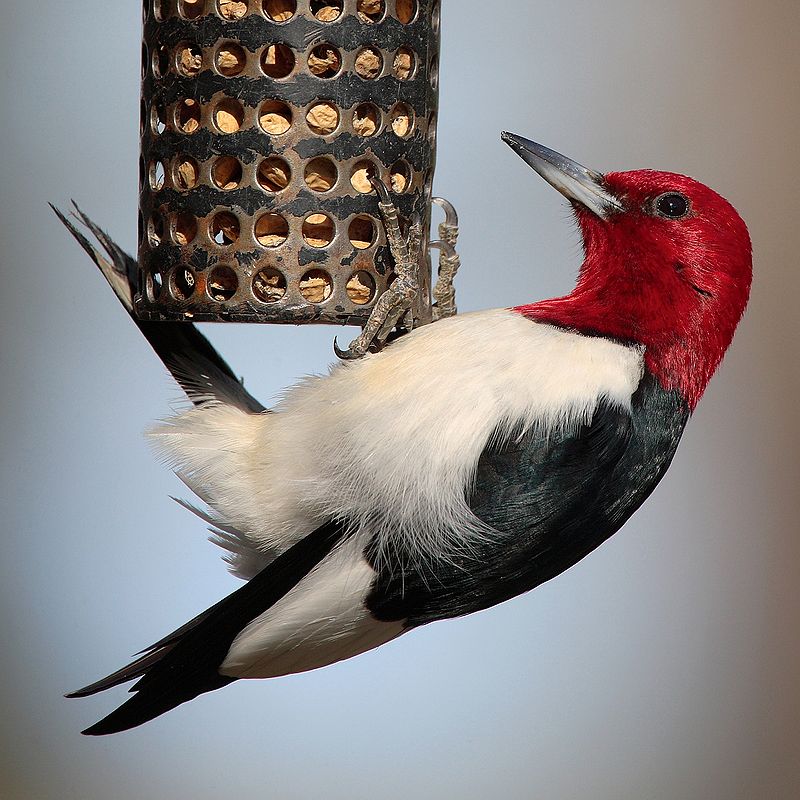
The red-headed woodpecker is a mid-sized bird found in temperate North America. It has striking plumage, with its head and neck being bright red, while the rest of its body is primarily black and white.
Its wings are rounder than other similar species, allowing it to maneuver through tight spaces easily when searching for food or shelter.
The breeding habitat of this bird consists mainly of open fields across Canada and the east-central United States.
Despite facing threats such as deforestation, urbanization, predation from larger birds, and collisions with windows or cars due to their inquisitive nature.
These birds remain listed on IUCN’s Red List as the least concerned, thanks largely to conservation efforts by local governments and organizations dedicated to protecting wildlife habitats.
Scientific classification:
| Kingdom | Animalia |
| Phylum | Chordata |
| Class | Aves |
| Order | Piciformes |
| Family | Picidae |
| Genus | Melanerpes |
| Species | M. erythrocephalus |
Also Featured In: Birds that Live in Mississippi, Red Birds You’ll Commonly Found in Texas
9. Purple Finch

The Purple Finch is a species of finch from North America belonging to the Fringillidae family. It’s also known as an “American Rosefinch” due to its resemblance in color and size to some European rosefinches.
Their plumage ranges from pinkish-purple on their heads and wings with a light brown underside. Small birds measure about 5-6 inches long with short, thin beaks for eating seeds and insects.
In addition, they have thick round bodies, which help them stay warm during cold winters in the northern parts of their range.
The Purple Finch has adapted well over time, making it easier for them to survive despite increasing threats posed by humans, such as deforestation or habitat destruction caused by development projects near their habitats.
Scientific classification:
| Kingdom | Animalia |
| Phylum | Chordata |
| Class | Aves |
| Order | Passeriformes |
| Family | Fringillidae |
| Subfamily | Carduelinae |
| Genus | Haemorhous |
| Species | H. purpureus |
Also Featured In: Magenta Birds You Didn’t Know, Birds in Iowa Spring
10. Scarlet Tanager

The Scarlet Tanager is a beautiful medium-sized bird in North and South America. It belongs to the Cardinal family and has striking red plumage with black wings and tail feathers.
Its song is similar to other cardinals yet also unique in its own way – it’s recognizable by its high whistles that become lower towards the end.
The species feeds mainly on insects and berries from trees or shrubs during the breeding season, when they may form loose flocks over open woodlands foraging for food.
They are highly territorial birds during nesting season, which happens between April and June; males and females fiercely defend their nests against intruders such as cats or squirrels.
Scientific classification:
| Kingdom | Animalia |
| Phylum | Chordata |
| Class | Aves |
| Order | Passeriformes |
| Family | Cardinalidae |
| Genus | Piranga |
| Species | P. olivacea |
Also Featured In: Yellow Connecticut Birds, Common Yellow Birds of Idaho
11. Common Redpoll
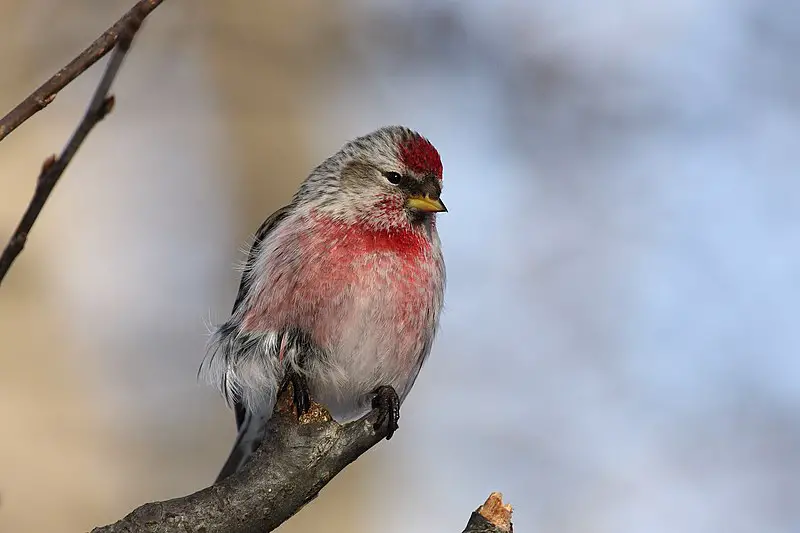
The Common Redpoll is a species of bird belonging to the finch family. It has an orange-red crown, white breast, and grey back with two black stripes running down either side.
Its wings are barred in browns, and its tail feathers have a grayish tinge at their tips. The redpoll breeds mainly south of Arctic regions in habitats that contain shrubs or thickets.
First classified by Linnaeus in 1758 under the binomial name Fringilla flammea, its genus Acanthis originates from the Ancient Greek acantha, meaning “thorn” or “prickle.”
This small yet colorful bird feeds mainly on seeds such as thistles during summer but switches to birch catkins when winter arrives – making them a common sight throughout much of North America and Eurasia.
Scientific classification:
| Kingdom | Animalia |
| Phylum | Chordata |
| Class | Aves |
| Order | Passeriformes |
| Family | Fringillidae |
| Subfamily | Carduelinae |
| Genus | Acanthis |
| Species | A. flammea |
Also Featured In: Finches Species, Most Common Winter Birds
12. Red Crossbill
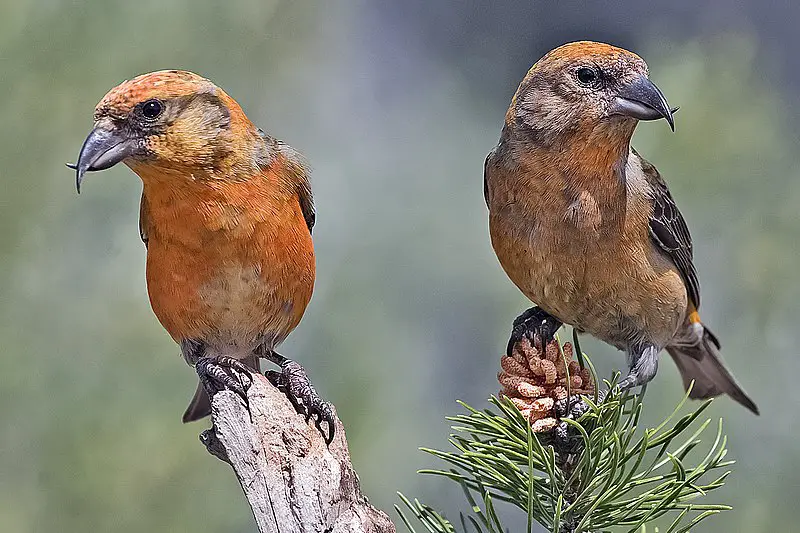
The Red Crossbill is a small passerine bird belonging to the finch family. It has distinctively crossed mandibles, which it uses to extract seeds from conifer cones and other fruits.
This species can be identified by its vivid colouring; males are red or orange in hue whilst females tend to have more green or yellow feathers.
Furthermore, there is considerable variation between individuals of this species regarding their beaks’ size and shape and their calls, ranging from short trills through chirps and harsh cackles up to loud rattling sounds.
They’re an interesting sight in many parts of Europe, particularly during winter months, where they often feed on pine cone seeds that drop down onto lower branches of trees.
Scientific classification:
| Kingdom | Animalia |
| Phylum | Chordata |
| Class | Aves |
| Order | Passeriformes |
| Family | Fringillidae |
| Subfamily | Carduelinae |
| Genus | Loxia |
| Species | L. curvirostra |
Also Featured In: Common Birds in Saskatchewan, Common Birds in Alberta
13. Cassin’s Finch
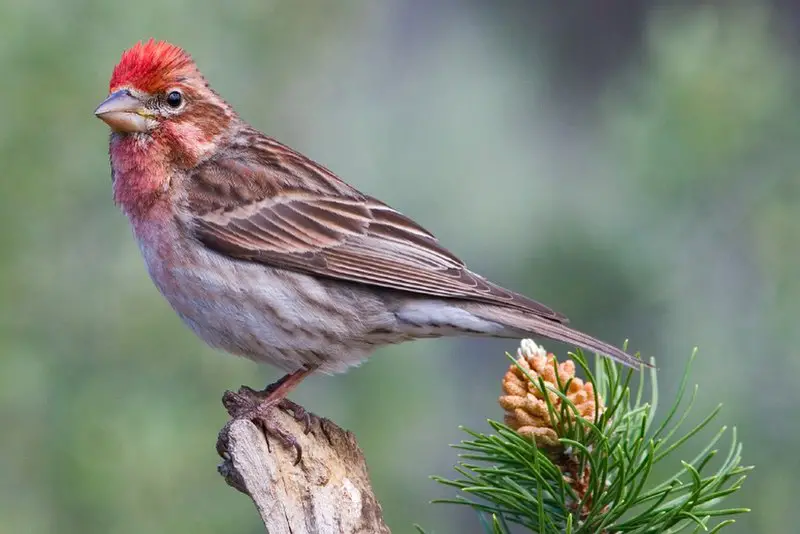
Cassin’s finch is a species of bird belonging to the Fringillidae family. It has brown wings and a tail, with a longer bill than that of the purple finch.
Adult males are raspberry red on their head, breast, back, and rump with streaked backs and undertail feathers.
The adult female Cassin’s Finch is duller in coloration than the male but still shows pinkish tones around its face and neck area and subtle streaks across its body.
This species can be found mainly in western North America from Alaska down to California, where they inhabit coniferous forests along mountain slopes or near riversides at elevations between 500-3000 meters above sea level.
They feed mainly on grasshoppers, caterpillars, and other insects that they pick up while foraging through vegetation or flying out onto open ground surfaces.
Scientific classification:
| Kingdom | Animalia |
| Phylum | Chordata |
| Class | Aves |
| Order | Passeriformes |
| Family | Fringillidae |
| Subfamily | Carduelinae |
| Genus | Haemorhous |
| Species | H. cassinii |
Also Featured In: Red birds You’ll See in Arizona, Red Birds You’ll See in Oklahoma
14. Two-Barred Crossbill
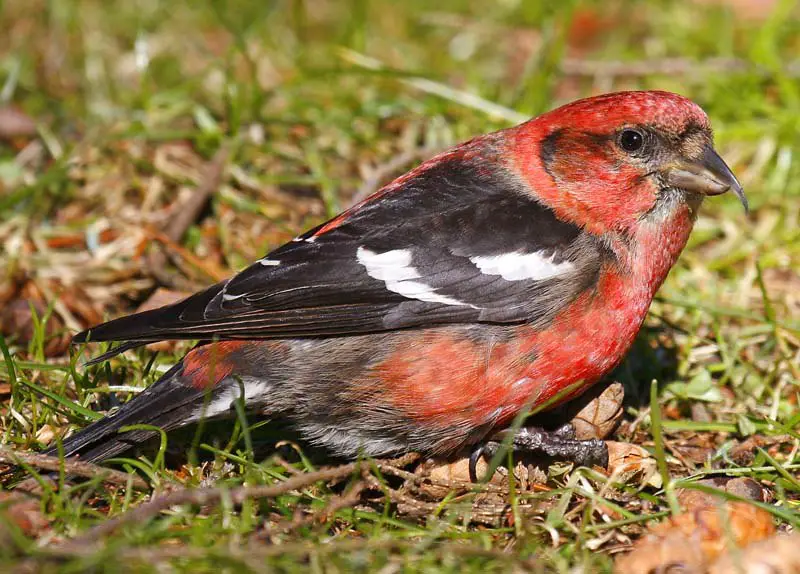
The Two-barred crossbill is a small passerine bird from the finch family Fringillidae.
It gets its scientific name, Loxia leucoptera, from Ancient Greek – with ‘Loxia’ meaning ‘crosswise’ and ‘leucoptera’ translating to “white-winged” in reference to its white wings.
The species has two subspecies: the white-winged crossbill (Loxia leucoptera leucoptera) that can be found in North America and the two-bar crossbill (Loxia leucocephala), which inhabits Europe, Asia as well as parts of northern Africa.
These birds feed mainly on conifer seeds but have also been seen consuming insects such as beetles or caterpillars during breeding season when food resources are scarce for their young ones.
They construct nests made out of twigs near trunks of spruce trees where they lay 2–6 eggs at one time.
Scientific classification:
| Kingdom | Animalia |
| Phylum | Chordata |
| Class | Aves |
| Order | Passeriformes |
| Family | Fringillidae |
| Subfamily | Carduelinae |
| Genus | Loxia |
| Species | L. leucoptera |
Also Featured In: Birds that Migrate through Illinois in the Spring, Red Minnesota Birds You Need to Know
15. Yellow-Bellied Sapsucker
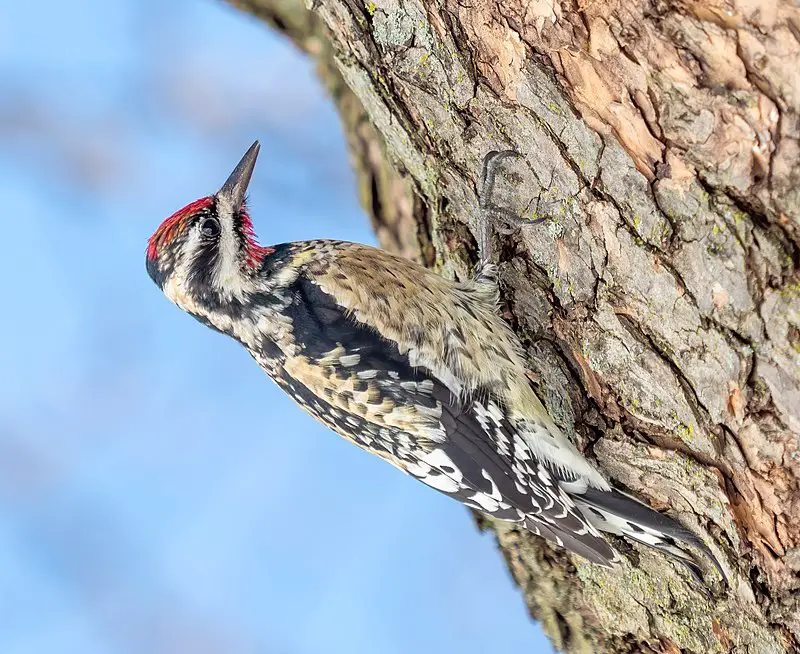
The Yellow-bellied Sapsucker is a medium-sized woodpecker that can be found in Canada and the northeastern United States.
It was first described by English naturalist Mark Catesby, who illustrated it with hand-colored plates for his book The Natural History of Carolina, Florida, and the Bahama Islands from 1729 to 1732.
This beautiful bird has white stripes on its black head, which contrast against its yellow throat, breast, and belly, making it stand out from other birds. Its wings are barred with red patches, adding to its beauty.
They also have white streaks on their sides and bold spots at their back, giving them a unique look among others.
Scientific classification:
| Kingdom | Animalia |
| Phylum | Chordata |
| Class | Aves |
| Order | Piciformes |
| Family | Picidae |
| Genus | Sphyrapicus |
| Species | S. varius |
Also Featured In: Woodpeckers Species, Long Island Birds You Should Know
16. Western Tanager
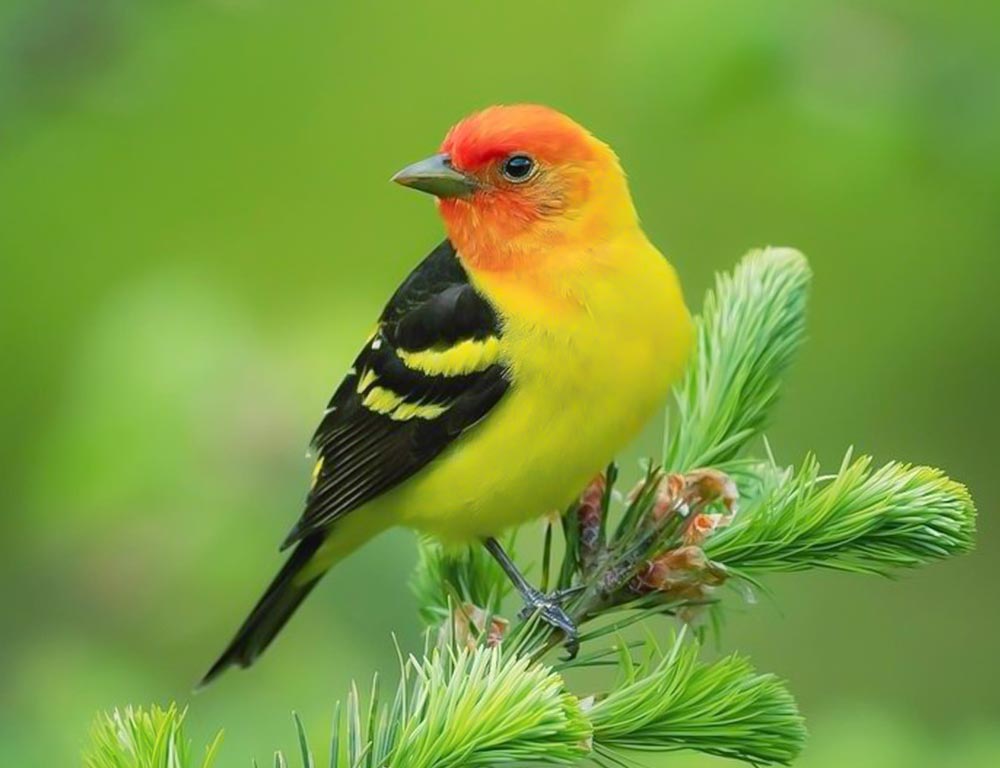
The Western Tanager (Piranga ludoviciana) is a medium-sized songbird from the cardinal family Cardinalidae. It was illustrated and formally described by American ornithologist Alexander Wilson in 1811.
The species has distinctive plumage, including yellow feathers on its wings and tail, red shoulders, a black head with a white forehead patch, and grayish underparts.
Its vocalizations are also very similar to other members of the cardinal family – they have a high-pitched ‘see’ note followed by several sweeter notes that come together as parts of complex songs.
They primarily feed on fruit but take insects when extra protein is available during the breeding season.
These beautiful birds can be found throughout western North America, from Alaska down through Mexico, making them an iconic part of many landscapes.
Scientific classification:
| Kingdom | Animalia |
| Phylum | Chordata |
| Class | Aves |
| Order | Passeriformes |
| Family | Cardinalidae |
| Genus | Piranga |
| Species | P. ludoviciana |
Also Featured In: Utah Birds, Birds that Found in the Yellowstone
17. Summer Tanager
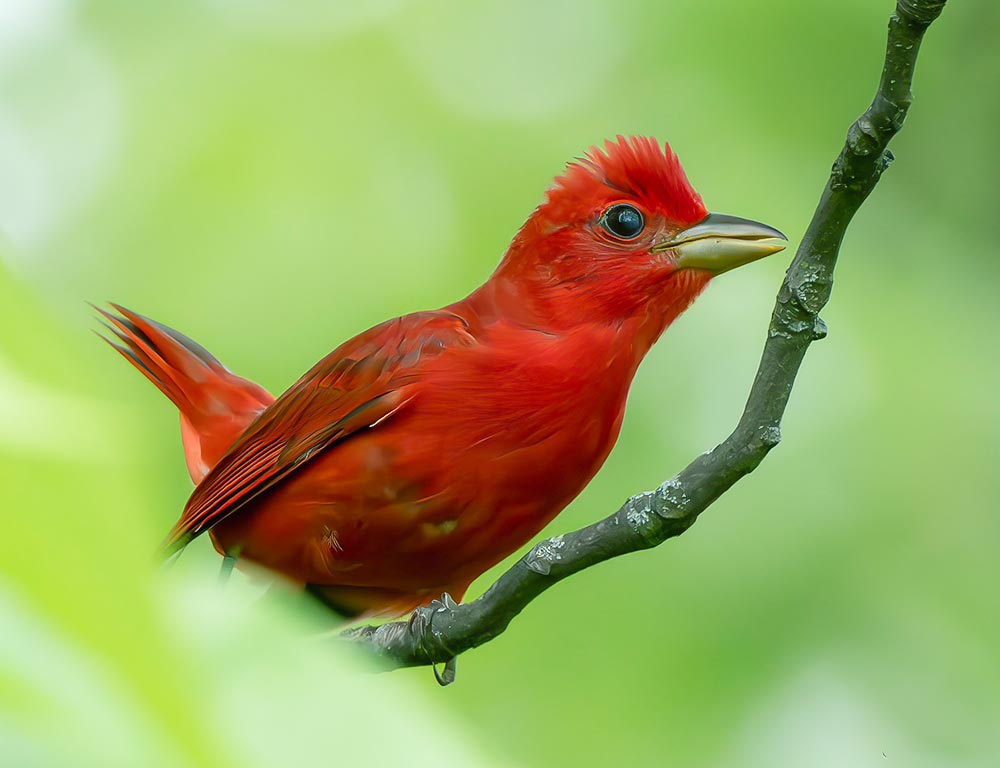
The Summer Tanager is a stunningly beautiful member of the cardinal family. Native to North and South America, this medium-sized songbird features striking red plumage on its back with yellow underparts.
It has a pointed black bill and long tail feathers that can be seen fluttering through the air when it flies.
The species’ vocalizations are quite similar to those of other members of its genus as well, which often include short whistles and chirps in addition to longer songs made up of various phrases or syllables.
With their vibrant colors and melodic voices, these birds make an eye-catching sight any time they appear.
Scientific classification:
| Kingdom | Animalia |
| Phylum | Chordata |
| Class | Aves |
| Order | Passeriformes |
| Family | Cardinalidae |
| Genus | Piranga |
| Species | P. rubra |
Also Featured In: birds of Arkansas, Most Common Songs Birds that Live around You
18. American Redstart
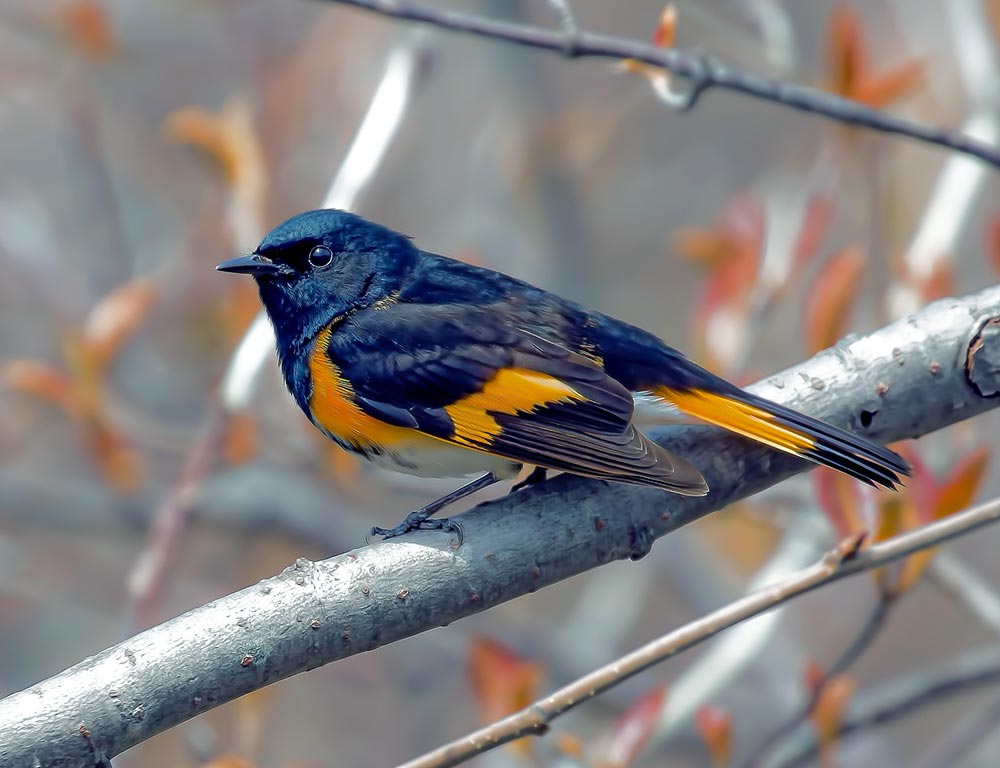
The American Redstart is a beautiful New World Warbler, first documented by Carl Linnaeus in 1758. An elegant black and orange plumage sets it apart from other birds.
The genus Setophaga comes from the Ancient Greek words ‘sēs’, meaning moth, and ‘phagos’, which means eating, referencing its insect-eating habits.
Its song is joyful, with short repeating phrases making up their melodic tune.
They are mostly found hopping around trees on their long legs during breeding season but migrate to Central America for winter months when food sources become scarce in North America.
Scientific classification:
| Kingdom | Animalia |
| Phylum | Chordata |
| Class | Aves |
| Order | Passeriformes |
| Family | Parulidae |
| Genus | Setophaga |
| Species | S. ruticilla |
Also Featured In: birds of Vermont, New Hampshire Birds You Should Know
19. Ring-Necked Pheasant
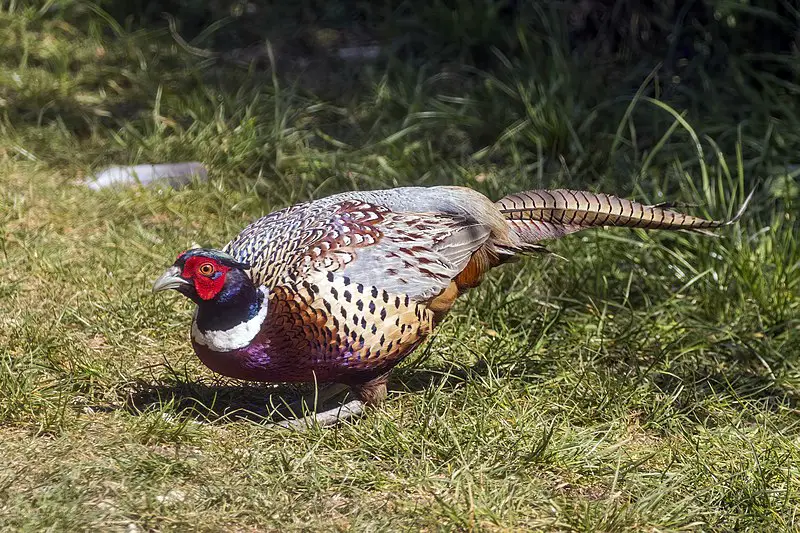
The Ring-necked Pheasant (Phasianus colchicus) is a stunning bird from the pheasant family. It has an iridescent green and gold plumage, bright red facial wattles, and white neck rings contrasting against its black tail feathers.
This elegant species can be found in fields, meadows, woodlands, and open areas across Northern Europe and East Asia, where it feeds on grain, insects, and other small animals. The male displays spectacular courtship rituals to attract mates.
He spreads his wings wide while making loud calls to signify dominance, which helps him establish territories for the breeding season.
Despite being hunted for food by both humans and predators like foxes and cats, this magnificent creature remains one of nature’s most beautiful sights.
Scientific classification:
| Kingdom | Animalia |
| Phylum | Chordata |
| Class | Aves |
| Order | Galliformes |
| Family | Phasianidae |
| Genus | Phasianus |
| Species | P. colchicus |
Also Featured In: birds of South Dakota, Most Common Romanian Birds
20. Northern Flicker

The Northern flicker is a woodpecker species found in North America, Central America, Cuba, and the Cayman Islands. This medium-sized bird is known for its unique migration behavior.
Over 100 common names are used to refer to the Northern Flicker, one of them being “yellowhammer”. It is a beautiful bird with distinctive markings and colorful plumage.
The Northern flicker is an important species in its ecosystem and plays a key role in maintaining a healthy balance in the environment.
Despite being a woodpecker, the Northern Flicker has a diverse diet that includes insects, fruits, and seeds.
It is fascinating to observe this bird as it pecks at trees in search of food, communicates with its unique vocalizations, and performs its incredible aerial displays.
The Northern Flicker is a remarkable bird species worthy of our admiration and protection.
Scientific classification:
| Kingdom | Animalia |
| Phylum | Chordata |
| Class | Aves |
| Order | Piciformes |
| Family | Picidae |
| Genus | Colaptes |
| Species | C. auratus |
Also Featured In: Birds That Live in Colorado, Birds Commonly Found in New York
Conclusion
The 20 red birds found in South Dakota are a remarkable aspect of the state’s diverse avian population. From the Northern Cardinal’s brilliant scarlet to the House Finch’s subtle hues, each species adds a splash of color and unique charm to the local ecosystems.
These birds not only enhance the natural beauty of South Dakota but also play vital roles in maintaining ecological balance through pollination, seed dispersal, and insect control.
Their presence underscores the importance of conserving natural habitats and biodiversity. As residents or visitors in South Dakota, we can observe these magnificent creatures, a reminder of nature’s intricate and colorful tapestry.